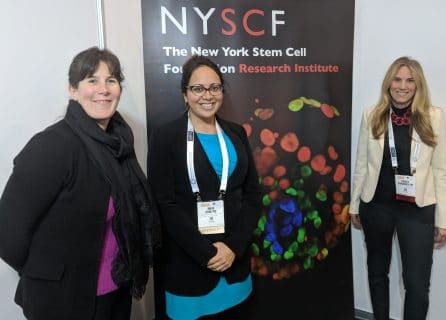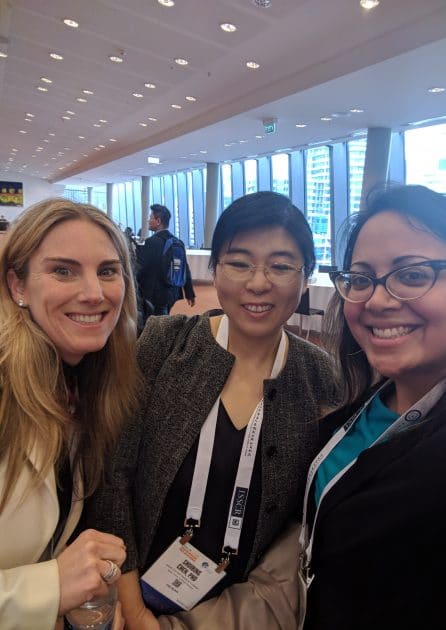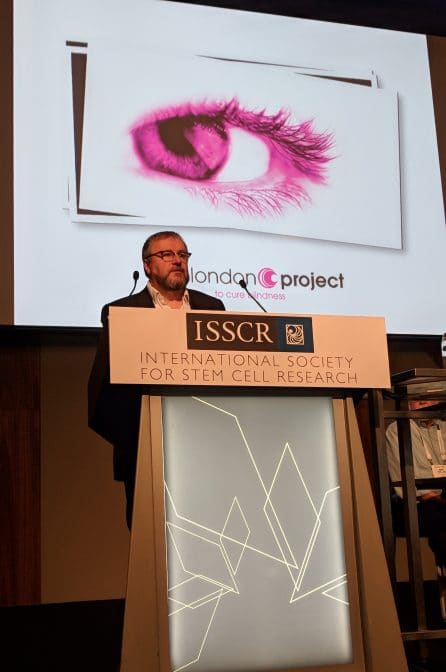International Society for Stem Cell Research Conference Showcases Promising Progress
NewsLast week, the annual meeting of the International Society for Stem Cell Research (ISSCR) convened over 3500 participants in Melbourne, Australia to share the latest advances in the field. NYSCF was represented among the scientists, exhibitors, and sponsors at the world’s largest scientific meeting focused on stem cells.
Incoming ISSCR President, Douglas A. Melton, PhD (Harvard University, Howard Hughes Medical Institute), a founding member of NYSCF’s Medical Advisory Board, hailed the impressive recent progress in stem cell research. Dr. Melton noted that the field has moved from producing stem cells towards controlling their fate and manufacturing cells for various purposes. Stem cells have led to improved models for disease research, he pointed out, and many new therapeutic applications. To build on these developments, Dr. Melton encouraged academic and non-profit research labs to take advantage of the “enormous opportunity” to increase interactions with pharmaceutical and biotech companies.

In this spirit, NYSCF scientist Cecile Terrenoire, PhD, presented a poster featuring one of NYSCF’s many ongoing collaborations with industry partners. Dr. Terrenoire’s project aims to use human induced pluripotent stem cells to predict whether drugs may inhibit embryonic development with an automated approach, which will enable simple screens before potentially toxic drugs enter clinical trials.
The value of collaborative research was evident in the interdisciplinary advances incorporating statistics, genomics, engineering, and various fields of medicine. As NYSCF – Robertson Stem Cell Investigator alumna Shuibing Chen, PhD (Weill Cornell Medical College), accepted the annual ISSCR Dr. Susan Lim Award for Outstanding Young Investigator, the first thing she did was thank her collaborators. “Science is never one person,” she said. Dr. Chen described her lab’s studies of how different chemicals guide stem cell development, and how they are applying this to diabetes research and drug discovery – highlighting her ongoing collaboration with NYSCF to explore how genetics affects drug response. NYSCF Innovators have won this award in 5 of the last 6 years, and Dr. Chen was one of many conference speakers from the NYSCF Innovator community.

Technological advances were also a clear driving force opening up new possibilities for stem cell research. The capacity to create organoids – ‘mini-brains’, for example – by combining stem cells differentiated into multiple cell types has allowed researchers to understand the mechanisms of disease in greater detail and has provided better testbeds for candidate drugs. Dr. Chen’s award, for example, recognized her work in this area. New technologies to measure the structure and function of genomes have also increased the power of stem cell research. NYSCF – Robertson Stem Cell Investigator Jennifer Phillips-Cremins, PhD (University of Pennsylvania) relayed a surprising discovery that genome ‘misfolding’ is associated with genetic disruptions that lead to disorders like Friedrich’s Ataxia and Huntington’s Disease. Numerous groups presented single-cell measurements of gene expression that have revealed new cell types and pinpointed critical aspects of organ development – many with implications for disease.
Chief among the biotechnological advances discussed was CRISPR technology, which has revolutionized stem cell research by allowing researchers to precisely edit genomes. Its myriad applications presented at the conference include studying the impact of genetic mutations in disease and engineering healthy cells for replacement therapies. A pioneer of CRISPR technology, Jennifer Doudna, PhD (University of California, Berkeley), delivered the keynote address. “The value of curiosity-based science cannot be overemphasized,” Dr. Doudna pointed out, reminding us that CRISPR was an unexpected discovery from basic research into how bacteria fight off viruses. Since then, efforts across the field, including those of NYSCF – Robertson Investigator Feng Zhang, PhD (Massachusetts Institute of Technology), have adapted CRISPR technology for use in stem cell-based disease research.

Perhaps the most exciting take-homes from the meeting were the many ways in which stem cell research is already on its way to helping patients. During the NYSCF-sponsored “Road to the Clinic” session, six researchers shared progress towards therapies for which clinical trials are imminent or underway. These included 2011 NYSCF – Robertson Stem Cell Prize recipient Pete Coffey, DPhil (University College London & University of California, Santa Barbara), who described his 15-year journey that culminated in a successful cellular therapy to restore eyesight in patients with age-related macular degeneration.
“When it comes to stem cell therapies, the question has always been: Are we there yet?” said the session chair. “I think we are.”
For more on the ISSCR conference, check out the conference website and the #ISSCR2018 hashtag on Twitter.